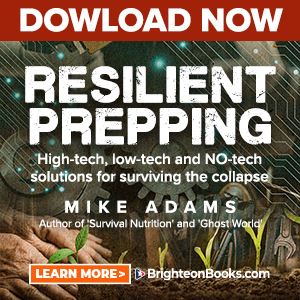Fukushima's radiation still so potent that even robots can't survive
Thursday, August 25, 2016 by: Samantha Debbie
Tags: TEPCO, Fukushima, robots

(NaturalNews) The site at which three Fukushima Daiichi reactors melted down in Japan more than six years ago remains a complete disaster zone, unsuitable for both humans and the electronic devices they have created. Though a massive cleanup is still underway, a lot must be done before the area can safely host human life again.
New information reveals that the radiation in the disaster zone is still so high that specialized robots built to assist in the cleanup are unable to function. Electronics designed by Tokyo Electric Power Company (TEPCO) and Toshiba have failed to perform the job they were created to do as a result of excessive radiation levels.
"The robots are designed to 'swim' in the radiated pools where the radioactive fuel rods are located, to search for and recover them," according to Fukushima Update.
Robots built to withstand high radiation prove faulty
However, the devices have been incapable of entering reactor number three, due to "concentrated levels of radiation" which exceed those found in reactor four, where an estimated 1,500 fuel rod assemblies were previously removed.Reports confirm that workers were able to stand close enough to the radioactive pool of water in an effort to observe the process in reactor four. However, reactor three, the most toxic and arguably the deadliest, remains essentially unreachable.
TEPCO was previously exposed for using inadequate equipment after it admitted to "accidentally" deploying monitoring equipment measuring radiation levels that maxed out at 100mSv, despite radioactivity being 18 times higher.
"Nobody was concerned that the reading was stuck at 100 for really long periods of time," notes Fukushima Update.
Suspicious TEPCO may still be concealing information about reactor meltdown
TEPCO maintains that radiation levels have fallen dramatically at the disaster site; however, the company's continual lies and coverups make confirming facts difficult. TEPCO admitted in February of this year that it waited two months to disclose the severity of the Fukushima disaster.The company knew within a matter of hours after the tsunami struck the plant on March 11, 2011, that a multi-reactor nuclear meltdown was underway. However, it refused to inform the public until April 2011.
"Despite the acknowledgement of wrong-doing in the press release, on the other hand, TEPCO says it didn't break the law, and did what was required when it reported the meltdowns to the Japanese Government within three days," reports Enviro News.
"But the company downplayed the severity to the public, allowing people to linger in worry, and to remain ignorant of the fact that dangerous radiation had already been spewed and rained down onto the population. And sadly, the Japanese government didn't let them know either."
In March 2016, three former TEPCO executives were indicted on charges of criminal negligence after being accused of "failing to take measures that would have protected the nuclear plant from the damage the tsunami wrought," the New York Times reported.
The former executives claimed it was impossible for them to foresee the disaster, which was invoked by a powerful earthquake that triggered a 15-meter tsunami, resulting in the meltdown of three of Fukushima's Daiichi reactors and the displacement of 100,000 residents.
The event killed 40 people and continues to affect the lives of thousands forever impacted by radiation-induced disease.
Fukushima robots could be used in everyday life, experts say
What exactly happens inside a nuclear reactor following a meltdown remains unknown, robotic engineer Hiroshi Endo told the LA Times, adding that the environment is less predictable than space.More than 100 different kinds of robots are actively working to resolve the issues at Fukushima, all capable of various maneuvers including the ability to walk, crawl and brave dust, debris and radiation levels strong enough to kill a human.
Some of the devices deploy dry ice that absorbs radiation, while others use high-pressure water. Experts say the robots could be "spun off into regular society" through their ability to transmit data through concrete walls.
TEPCO says the Fukushima disaster zone is stable, allowing thousands of employees to assist in the cleanup, "pumping water into the devastated reactors to cool them and storing the contaminated water in massive tanks."
However, the long-term effects of the radioactive disaster on people and wildlife remain largely unknown.
Sources:
FukushimaUpdate.com
NaturalNews.com
EnviroNews.tv
FukushimaWatch.com
LATimes.com
TEPCO at FETCH.news
Get independent news alerts on natural cures, food lab tests, cannabis medicine, science, robotics, drones, privacy and more.
Take Action: Support Natural News by linking to this article from your website
Permalink to this article:
Embed article link: (copy HTML code below):
Reprinting this article:
Non-commercial use OK, cite NaturalNews.com with clickable link.
Follow Natural News on Facebook, Twitter, Google Plus, and Pinterest
- Criminal referral requests filed against Fauci and top COVID officials in seven states
- Photonic revolution: New chips process data using light instead of electricity
- Dane Wigington exposes climate engineering as ‘All-Out Weather and Biological Warfare’
- Pfizer's RSV vaccine linked to preterm births as drug giant CONCEALED RISKS from pregnant women in unethical clinical trials
- Sen. Johnson demands COVID vaccine makers hand over all documents, communications, as evidence against their products reaches a climax
- Aluminum, essential to vaccine science, also causes serious health conditions, including chronic fatigue, neurodegenerative diseases, macrophagic myofasciitis
- Israeli lobbyists boast of controlling US national security policy in leaked AIPAC audio
- Aerosolized bioweapons? Strange “diploid biomasses” falling out of the sky in Florida captured under the microscope
- DOGE unveils $400M unemployment fraud scandal: Toddlers, futuristic birthdates fuel outcry
- Analysis: The coming economic collapse, a mass uprising and Trump's three secret weapons to halt the growing revolt
- Tulsi Gabbard leads charge against the Biden regime’s global censorship of the 'Disinformation Dozen'
- Chemtrails unveiled: How the CIA and Big Business are manipulating the weather for profit
- Shedding light on the dark side of MMR vaccines: How vaccinated individuals SPREAD MEASLES & put the vulnerable at risk
- Fauci is back in the limelight, and he’s busy promoting a future COVID or FLU pandemic
- Widespread social and economic unrest: Steve Quayle issues urgent financial warning of imminent asset collapse in new interview with Mike Adams
- Gardening tips: 15 Simple tricks to double your garden’s yield this season
- Oats: A nutritional powerhouse for health and wellness
- U.S. lawmakers investigate Meta over alleged China collaboration
- Aerosolized bioweapons? Strange “diploid biomasses” falling out of the sky in Florida captured under the microscope
- Widespread social and economic unrest: Steve Quayle issues urgent financial warning of imminent asset collapse in new interview with Mike Adams
- Tulsi Gabbard leads charge against the Biden regime’s global censorship of the 'Disinformation Dozen'
- Fauci is back in the limelight, and he’s busy promoting a future COVID or FLU pandemic
- Analysis: The coming economic collapse, a mass uprising and Trump's three secret weapons to halt the growing revolt
- Kiss Your Genetic Privacy Good-Bye! 23andMe Gets Green Light to Sell Your Intimate Genetic Details to Anyone They Want
- CLOT SHOT PLANDEMIC UNFOLDING: Fibrous, rubbery clots caused by covid injections have prion-like seeding activity
- Mike Adams releases country western hit single: Goin’ Back in Time is Comin’ Home
- DEATH by VACCINE or face PRISON time: Canadian Freedom Convoy leaders CONVICTED for protesting forced vaccination during the Covid Plandemic
- Tulsi Gabbard takes aim at censorship: Justice for the ‘Disinformation Dozen’
- How Israeli military-connected corporations are secretly controlling your online privacy
- European Court of Justice: Healthcare professionals who promoted or administered COVID-19 vaccines are CRIMINALLY LIABLE for any harm caused
- Defunding DEADLY mRNA jabs: Government funding for mRNA technology being scrutinized and sidelined until proven "safe and effective" for real
- U.S. lawmakers investigate Meta over alleged China collaboration
- Federal employees whine over DOGE's new directive requiring them to do a 5-point summary of weekly accomplishments
- U.S. approves new Russian ambassador as diplomatic thaw continues
- Trump administration poised to overhaul crypto regulations with new SEC leadership
- I Want My Bailout Money – new song and music video released by Mike Adams
- Newly released JFK files reveal Pentagon's role in creating Lyme disease and covid in the same lab
- Analysis: The coming economic collapse, a mass uprising and Trump's three secret weapons to halt the growing revolt
- Mike Adams releases country western hit single: Goin’ Back in Time is Comin’ Home
- MEDICAL BOMBSHELL: FDA admits Covid mRNA 'Vaccines' CAUSE CANCER
- Aerosolized bioweapons? Strange “diploid biomasses” falling out of the sky in Florida captured under the microscope
- Trump reverses course on Gaza plan, says “nobody is expelling Palestinians”
- Dr. Mike Yeadon releases 15-minute testimony - WATCH - about genocidal intent of COVID “vaccines”
- Kiss Your Genetic Privacy Good-Bye! 23andMe Gets Green Light to Sell Your Intimate Genetic Details to Anyone They Want
- 5 Simple steps to boost your brainpower: How to strengthen executive function in a distracted world
- A lack of integrity in Academia: Harvard professor found GUILTY of fraudulent research to promote CRT theory
- The Health Ranger releases “Vaccine Zombie” song and music video, using AI-animated zombies for the music video
- California's social media censorship law struck down: A victory for free speech or a threat to online safety?
- Rep. Nancy Mace introduces bill to ban biological males from female facilities on federal property
- EPA advisor admits the agency is funneling billions to climate groups ahead of Trump’s return to White House
- Survival 101: Effective EMF blocking techniques
- OpenAI whistleblower who dissented against how the company trained ChatGPT found dead
- Space war brewing? Russia threatens to destroy Starlink satellites
- European Court of Justice: Healthcare professionals who promoted or administered COVID-19 vaccines are CRIMINALLY LIABLE for any harm caused
- Red Cross issues warning to stop blood plasma donations from vaccinated people
- Scientists confirm: GENIUS brain function can be spontaneously unleashed in humans without any apparent cause
- EPA advisor admits the agency is funneling billions to climate groups ahead of Trump’s return to White House
- HYSSOP: What research reveals about the health benefits of this ancient holy herb
- Two containers with completed ballots fall out of truck in Florida
- Newly released JFK files reveal Pentagon's role in creating Lyme disease and covid in the same lab
- Global leaders unite to clamp down on “misinformation” with UN-backed Cascais Declaration
- Fully vaccinated about to see “tsunami” of illness and death, warns virologist
- BREAKING: 2025 NDAA authorizes mandatory military draft of WOMEN across America… as Pentagon pursues global NUCLEAR war with both Russia and China at the same time
- Michael Yon warns of a ZIONIST TAKEOVER in Trump’s second administration
- Ozempic and Wegovy weight loss drugs are injectable LIZARD VENOM PEPTIDES that may unleash a devastating wave of organ failure… side effects align with symptoms of SNAKE BITES
- The Health Ranger releases “Vaccine Zombie” song and music video, using AI-animated zombies for the music video
- BOMBSHELL: DNA testing kits are a SCAM to develop ethnic-specific bioweapons
- Mike Adams releases country western hit single: Goin’ Back in Time is Comin’ Home
- Israeli soldiers accused of even more torture and abuse in the West Bank
- These 13 countries just signed an agreement to engineer a global FAMINE by destroying food supply
- NASA admits that climate change occurs because of changes in Earth’s solar orbit, and NOT because of SUVs and fossil fuels
- RFK Jr. clears key hurdle: Sen. Susan Collins backs controversial HHS nominee, signaling a new era for health policy
Science News & Studies
Medicine News and Information
Food News & Studies
Health News & Studies
Herbs News & Information
Pollution News & Studies
Cancer News & Studies
Climate News & Studies
Survival News & Information
Gear News & Information
News covering technology, stocks, hackers, and more



"Big Tech and mainstream media are constantly trying to silence the independent voices that dare to bring you the truth about toxic food ingredients, dangerous medications and the failed, fraudulent science of the profit-driven medical establishment.
Email is one of the best ways to make sure you stay informed, without the censorship of the tech giants (Google, Apple, Facebook, Twitter, YouTube, etc.). Stay informed and you'll even likely learn information that may help save your own life."
–The Health Ranger, Mike Adams











































